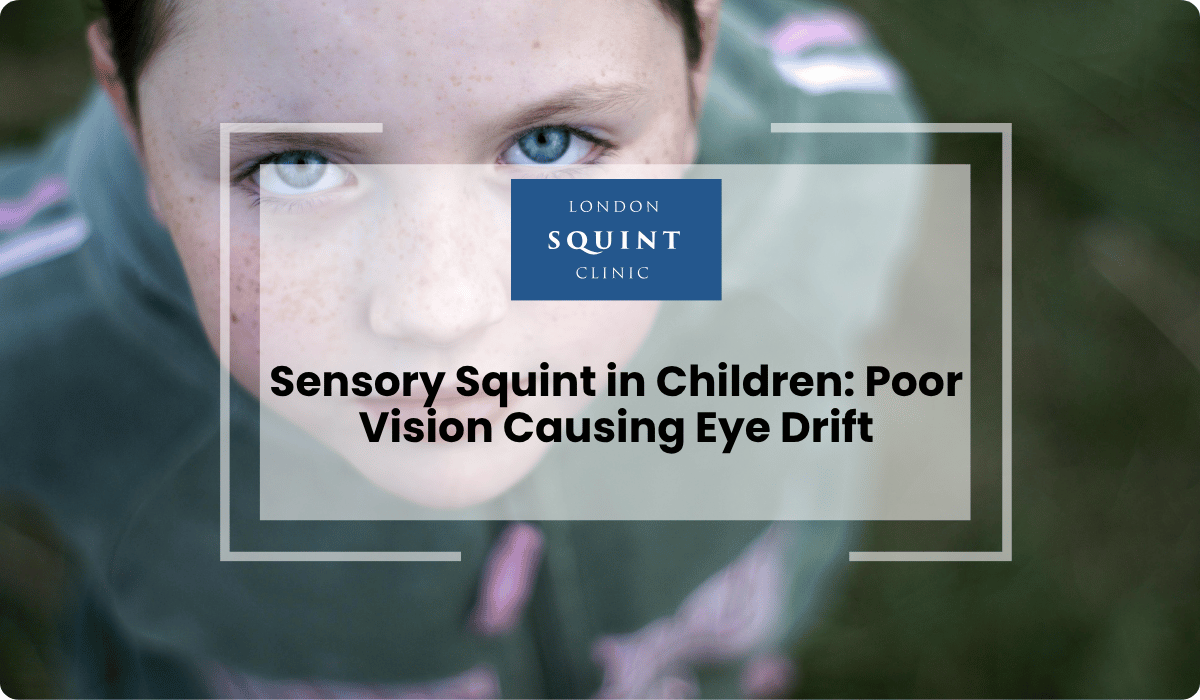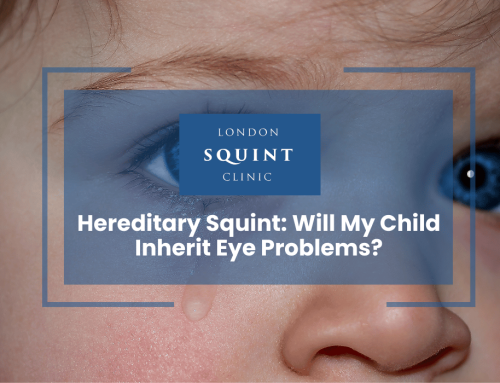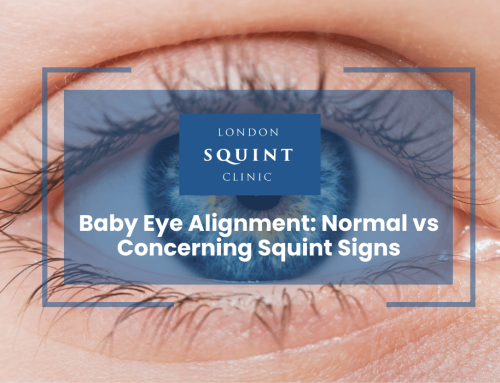Sensory Squint in Children: Poor Vision Causing Eye Drift
- Sensory squint (sensory strabismus) develops when poor vision in one eye disrupts normal binocular vision, causing the affected eye to drift out of alignment.
- Early detection is crucial—parents should watch for signs like noticeable eye misalignment, abnormal head posturing, poor depth perception, and frequent eye rubbing or squinting.
- Amblyopia (lazy eye) and strabismus have a bidirectional relationship, potentially creating a cycle where vision loss leads to misalignment, which further worsens vision.
- Prevention strategies include routine vision screening beginning in infancy, prompt treatment of vision problems, and monitoring children with risk factors.
- Treatment typically involves addressing the underlying vision problem, managing amblyopia through patching or other therapies, and potentially correcting eye misalignment with prism glasses or surgery.
- Long-term management requires ongoing monitoring as children grow, with regular reassessment of visual function and eye alignment to ensure interventions remain appropriate.
Table of Contents
- Understanding Sensory Squint: Causes and Mechanisms
- How Poor Vision Leads to Eye Misalignment in Children
- Diagnosing Sensory Squint: Signs Parents Should Watch For
- The Connection Between Amblyopia and Developing Strabismus
- Can Sensory Squint Be Prevented? Early Intervention Strategies
- Treatment Options for Children with Vision-Related Eye Drift
- Long-Term Outlook: Managing Sensory Squint in Growing Children
Understanding Sensory Squint: Causes and Mechanisms
Sensory squint, also known as sensory strabismus, is a specific type of eye misalignment that develops as a consequence of poor vision in one eye. Unlike other forms of strabismus that may be caused by muscle or nerve abnormalities, sensory squint occurs when the brain receives significantly different visual inputs from each eye, disrupting the normal binocular vision process.
The primary mechanism behind sensory squint involves the breakdown of sensory fusion—the brain’s ability to combine images from both eyes into a single, three-dimensional perception. When vision in one eye is compromised, the brain cannot effectively merge the two images, leading to a gradual drift of the affected eye. This visual pathway development disruption is particularly concerning in children, whose visual systems are still developing.
Common causes of sensory squint in children include:
- Congenital cataracts or corneal opacities
- Retinal disorders such as retinopathy of prematurity
- Optic nerve abnormalities
- Severe refractive errors (particularly if asymmetric between eyes)
- Trauma to the eye affecting visual clarity
- Macular or retinal scarring
The timing of vision loss is crucial—early-onset vision problems during critical periods of visual development (typically the first 8-10 years of life) pose the highest risk for developing sensory squint. Understanding these mechanisms helps clinicians identify children at risk and implement appropriate interventions before permanent visual impairment occurs.
How Poor Vision Leads to Eye Misalignment in Children
The development of eye alignment in children relies heavily on clear vision in both eyes during critical developmental periods. When a child experiences poor vision in one eye, a cascade of neurological and physiological changes can lead to eye misalignment. This process of sensory fusion disruption explains why vision loss and strabismus are often interconnected.
In normal visual development, both eyes send equally clear images to the brain, which fuses these images to create a single, three-dimensional perception. This process, known as binocular fusion, requires:
- Similar visual acuity in both eyes
- Proper alignment of the visual axes
- Functional neural pathways to process visual information
When unilateral vision loss occurs, the brain receives a clear image from the healthy eye but a blurry or distorted image from the affected eye. Over time, the brain begins to suppress or ignore the poor-quality input from the affected eye. Without the neural stimulus that maintains proper alignment, the eye with reduced vision gradually drifts, typically outward (exotropia) or sometimes inward (esotropia).
This drift occurs because the eye no longer participates effectively in binocular vision. The ocular misalignment becomes more pronounced as the brain increasingly relies on the healthy eye for visual information. In young children, this process can happen relatively quickly due to the plasticity of the developing visual system, making early detection and intervention crucial for preventing permanent visual impairment and cosmetic concerns.
The severity of the sensory squint often correlates with the degree of vision loss and the age of onset—earlier vision loss typically results in more significant misalignment as it interferes with the establishment of normal binocular vision during critical developmental windows.
Diagnosing Sensory Squint: Signs Parents Should Watch For
Early detection of sensory squint requires vigilance from parents and primary care providers, as children may not complain about vision problems they’ve always experienced. Recognising the subtle signs of sensory strabismus can lead to timely intervention and better visual outcomes.
Key signs that parents should watch for include:
- Noticeable eye misalignment, particularly when the child is tired or unwell
- Abnormal head posturing (tilting or turning to compensate for vision problems)
- Frequent eye rubbing or squinting
- Poor depth perception (difficulty catching balls or navigating steps)
- Closing one eye when focusing on near tasks
- White pupillary reflex in photographs (instead of the normal red reflex)
- Asymmetric corneal light reflexes when a torch is shone at the eyes
Diagnosis of sensory squint involves a comprehensive pediatric eye assessment that typically includes:
- Visual acuity testing (adapted for the child’s age and communication abilities)
- Refraction assessment to identify any significant refractive errors
- Examination of eye alignment using cover tests and prism measurements
- Evaluation of eye movements and fixation patterns
- Dilated fundus examination to assess the retina, optic nerve, and other structures
- Specialised imaging such as OCT or ultrasound when structural abnormalities are suspected
A key diagnostic feature that distinguishes sensory squint from other forms of strabismus is the identification of an underlying cause for reduced vision in the misaligned eye. The ophthalmologist will specifically look for evidence of ocular pathology that could explain the vision loss, such as cataracts, retinal abnormalities, or optic nerve issues. This comprehensive approach ensures appropriate treatment targeting both the underlying vision problem and the resulting eye misalignment.
The Connection Between Amblyopia and Developing Strabismus
The relationship between amblyopia (lazy eye) and strabismus is bidirectional and complex, particularly in the context of sensory squint. Understanding this connection is crucial for effective management of both conditions in children.
Amblyopia refers to reduced vision in one or both eyes due to abnormal visual development during early childhood. It occurs when the brain favours one eye over the other, eventually suppressing visual input from the weaker eye. This suppression can lead to permanent vision loss if not addressed during the critical period of visual development.
In the context of sensory squint, the connection works in two primary ways:
Amblyopia leading to strabismus: When a child develops amblyopia due to uncorrected refractive errors, cataracts, or other causes of poor vision, the brain may gradually suppress the visual input from the affected eye. Without the neural stimulus that maintains proper alignment, the eye may drift out of position, resulting in sensory strabismus. This pattern is particularly common when amblyopia is severe and occurs early in life.
Strabismus contributing to amblyopia: Conversely, when a child has strabismus for other reasons (such as muscle imbalance), the misaligned eye sends images that conflict with those from the properly aligned eye. To avoid double vision, the brain may suppress the input from the misaligned eye, potentially leading to amblyopia in that eye.
This interconnected relationship creates a potential vicious cycle where vision loss leads to misalignment, which can further worsen vision. Breaking this cycle requires comprehensive treatment addressing both the amblyopia and the strabismus. Early intervention is particularly important, as the visual system’s plasticity diminishes with age, making treatment progressively more challenging beyond the first decade of life.
Can Sensory Squint Be Prevented? Early Intervention Strategies
While not all cases of sensory squint can be prevented, early intervention strategies can significantly reduce the risk and severity of this condition. Prevention focuses primarily on identifying and addressing vision problems before they lead to eye misalignment.
Routine Vision Screening: Regular vision assessments beginning in infancy are crucial for early detection of vision problems. The UK National Screening Committee recommends vision screening for all children at age 4-5 years, but earlier examinations are advisable for children with risk factors such as prematurity, family history of eye conditions, or developmental delays.
Prompt Treatment of Vision Problems: Timely correction of refractive errors with appropriate glasses can prevent the development of amblyopia and subsequent sensory squint. Similarly, early intervention for conditions like congenital cataracts, typically within the first few months of life, can preserve visual development and prevent misalignment.
Monitoring High-Risk Children: Children with certain conditions require vigilant monitoring for vision problems:
- Premature infants, particularly those with a history of retinopathy of prematurity
- Children with developmental disorders or syndromes associated with vision problems
- Those with a family history of strabismus, amblyopia, or early-onset eye diseases
- Children who have experienced eye trauma or infections
Balanced Visual Stimulation: Ensuring both eyes receive equal visual stimulation is important for normal binocular development. This may involve patching therapy for early amblyopia or alternating occlusion techniques to strengthen the weaker eye before misalignment occurs.
Parent Education: Teaching parents about normal visual development milestones and warning signs of vision problems empowers them to seek timely care. Parents should be alert to signs such as abnormal eye appearance, poor visual tracking, or unusual head postures that might indicate developing vision problems.
When implemented consistently, these preventive strategies can significantly reduce the incidence and severity of sensory squint, preserving both visual function and normal eye alignment in vulnerable children.
Treatment Options for Children with Vision-Related Eye Drift
Managing sensory squint in children requires a comprehensive approach that addresses both the underlying vision problem and the resulting eye misalignment. Treatment strategies are typically tailored to the child’s age, the severity of vision loss, and the degree of strabismus.
Addressing the Underlying Vision Problem:
- Optical Correction: Prescription glasses or contact lenses to correct significant refractive errors, particularly if asymmetric between eyes
- Cataract Surgery: Prompt surgical removal of congenital or developmental cataracts, followed by appropriate optical correction
- Treatment of Retinal Conditions: Laser therapy, medications, or surgical interventions for retinal disorders that compromise vision
- Management of Optic Nerve Abnormalities: While many optic nerve conditions cannot be reversed, proper diagnosis and management can prevent further deterioration
Amblyopia Treatment:
- Patching Therapy: Covering the stronger eye for prescribed periods to encourage use of the weaker eye
- Atropine Penalisation: Using atropine drops in the stronger eye to temporarily blur vision, forcing use of the weaker eye
- Vision Therapy: Structured visual activities designed to improve visual processing and eye coordination
Management of Eye Misalignment:
- Prism Glasses: Special lenses that bend light to compensate for eye misalignment, potentially helping with double vision
- Botulinum Toxin Injections: Temporary weakening of specific eye muscles to improve alignment, sometimes used as a diagnostic tool before surgery
- Strabismus Surgery: Surgical realignment of the eyes by adjusting the tension of the extraocular muscles
Timing Considerations: The timing of interventions is critical. Treatment for the underlying vision problem should be initiated as early as possible to maximise visual potential. Strabismus surgery, if needed, is often delayed until vision has been optimised in the affected eye, unless the misalignment is severe or causing significant functional or psychosocial issues.
It’s important to note that even when vision cannot be fully restored in the affected eye, strabismus surgery may still be beneficial for cosmetic reasons and to expand the visual field. The decision regarding surgical intervention should be made collaboratively between the ophthalmologist, the child (when age-appropriate), and the parents, considering both functional and psychosocial factors.
Long-Term Outlook: Managing Sensory Squint in Growing Children
The long-term management of sensory squint requires ongoing attention as children grow and develop. Understanding the prognosis and establishing appropriate follow-up care are essential components of comprehensive treatment.
Developmental Considerations: As children grow, their visual needs change, particularly during school years when academic demands increase. Regular reassessment of visual function and eye alignment is necessary to ensure that interventions remain appropriate. Growth spurts can sometimes affect eye alignment, necessitating adjustments to treatment plans.
Visual Rehabilitation: Even after the acute phase of treatment, ongoing visual rehabilitation may be beneficial. This might include:
- Continued part-time patching or visual exercises to maintain improvements in the weaker eye
- Regular updates to optical prescriptions as refractive errors change
- Specialised academic accommodations for children with permanent visual impairment
Monitoring for Recurrence: Children with a history of sensory squint require vigilant monitoring for recurrence, particularly during periods of rapid growth or after illness. Parents should be educated about signs that might indicate regression, such as increasing eye drift or complaints of visual changes.
Psychosocial Support: The visible nature of strabismus can have significant psychosocial impacts on children. Support may include:
- Counselling to address self-esteem issues related to appearance or visual limitations
- Education for teachers and peers about the child’s condition
- Connection with support groups for families of children with visual impairments
Transition to Adult Care: As children approach adulthood, planning for transition to adult ophthalmology services becomes important. This transition should include comprehensive documentation of the child’s history, treatments, and ongoing needs.
Prognosis Factors: Several factors influence the long-term outlook for children with sensory squint:
- Age
Frequently Asked Questions
What is the difference between sensory squint and other types of strabismus?
Sensory squint (sensory strabismus) specifically develops as a consequence of poor vision in one eye, while other types of strabismus may be caused by muscle or nerve abnormalities. In sensory squint, the eye misalignment occurs because the brain cannot effectively merge images from both eyes due to significantly different visual inputs. This condition typically results in the affected eye drifting outward (exotropia) or sometimes inward (esotropia) as the brain increasingly relies on the healthy eye for visual information.
At what age should children be screened for vision problems to prevent sensory squint?
While the UK National Screening Committee recommends vision screening for all children at age 4-5 years, earlier examinations are advisable for children with risk factors. Ideally, all infants should have their eyes checked at birth and during well-child visits. Children with risk factors such as prematurity, family history of eye conditions, or developmental delays should receive comprehensive eye examinations by 6-12 months of age. Early detection and intervention are crucial as most vision problems that lead to sensory squint can be effectively treated during the critical period of visual development (first 8-10 years).
Can sensory squint be corrected with glasses alone?
Glasses alone may correct sensory squint in some cases, particularly when the underlying cause is a significant refractive error (need for glasses) that has led to amblyopia. By correcting the refractive error and improving vision in the affected eye, the brain may regain the ability to use both eyes together, potentially resolving the misalignment. However, if the vision loss is severe or longstanding, or if there are structural problems with the eye, glasses alone are usually insufficient. In these cases, a combination of treatments including patching therapy, vision therapy, and possibly surgery may be necessary.
Is surgery always necessary for children with sensory squint?
Surgery is not always necessary for children with sensory squint. The decision depends on several factors including the severity of the misalignment, the degree of vision recovery possible, and the impact on the child’s function and well-being. If the underlying vision problem can be successfully treated early and vision improves significantly, the eye alignment may improve without surgery. However, when vision cannot be fully restored or when significant misalignment persists despite vision treatment, surgery may be recommended to improve cosmetic appearance, expand the visual field, and potentially enhance binocular function.
What is the success rate of treatment for sensory squint in children?
The success rate of treatment for sensory squint varies depending on the cause, severity, and timing of intervention. When detected and treated early (before age 7-8), the prognosis is generally favorable. Treatment success rates for the underlying vision problems range from 60-90% for amblyopia therapy and up to 80% for surgical alignment, though multiple procedures may be needed in some cases. The best outcomes occur when treatment begins before age 2 for severe vision problems like congenital cataracts. However, even with delayed diagnosis, cosmetic improvements through surgery can be achieved at any age, though functional visual recovery may be limited after the critical period of development.
Can a child outgrow sensory squint without treatment?
A child cannot typically outgrow sensory squint without treatment. Unlike some forms of intermittent strabismus that may improve with age, sensory squint is directly related to poor vision in one eye. Without addressing the underlying vision problem, the eye misalignment usually persists or worsens over time as the brain increasingly relies on the better-seeing eye. Early intervention is essential to prevent permanent vision loss (amblyopia) and to give the child the best chance for normal binocular vision development. The longer sensory squint remains untreated, the more difficult it becomes to achieve optimal visual outcomes.
How does sensory squint affect a child’s learning and development?
Sensory squint can significantly impact a child’s learning and development in multiple ways. Reduced depth perception may affect coordination and spatial awareness, making activities like catching balls, navigating stairs, or learning to write more challenging. Children may develop compensatory head postures to optimize their vision, potentially leading to neck and back problems. Reading efficiency and stamina may be compromised, affecting academic performance. Additionally, the visible nature of eye misalignment can lead to social challenges, including teasing and self-esteem issues. Early intervention is crucial not only for visual outcomes but also to minimize these developmental, academic, and psychosocial impacts.
Find out if you are suitable for Double Vision Treatment
Not everyone is eligible for double vision surgery.
Find out if you could benefit from this life-changing surgery by taking the quick self-suitability quiz below:
Our most popular procedures

Hello, I’m Nadeem Ali
I’m one of the few eye surgeons in the world with 100% focus on Squint and Double Vision Surgery.
I have 24 years of eye surgery experience, and worked for 13 years as a Consultant at London’s renowned Moorfields Eye Hospital.
In 2023, I left the NHS to focus fully on treating patients from across the world at the London Squint Clinic. You can read more about me here.
There’s lots of information on the website about: squint surgery, double vision surgery and our pricing.
The most rewarding part of my job is hearing patients tell me how squint or double vision surgery has changed their lives. You can hear these stories here.
Mr Nadeem Ali
MA MB BChir MRCOphth FRCSEd(Ophth)





